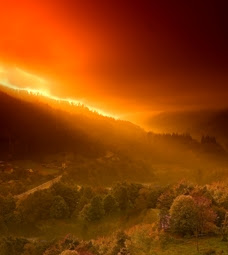Art often imitates life. There are artists who take this phrase literally and create paintings that look so realistic that they are mistaken for photographs. Some people are not fond of this style of painting, known as photorealism. They feel that it lacks an expression of the artist's inner feelings and experiences. For me, however, paintings that look like photographs are greatly impressive. I like the way they represent life as it is and have no underlying sense of abstraction. I am able to focus on the simple aesthetic beauty of the work and appreciate how much skill must be needed to accurately replicate a photograph using nothing but brushes and paint.
Just over a week ago, I attended a friend's art exhibition. Her work was also an example of art imitating life. But it was not a collection of paintings. It was a little room behind a glass screen, with a desk and chair, biology notes on the wall, a couple of pot plants, a geometric shape made of pencil leads, and a carefully balanced stack of books and CDs. There were a number of other objects strewn arbitrarily around the room. It was this lack of order that prevented me from truly appreciating what this artwork had to offer.
I have now interpreted the work as a metaphor for mental clutter. Additionally, I would like to think that the work represents the transformation of clutter into clarity. Let me explain. Life may seem random and patternless at times, yet we are still able to exert a certain amount of control over it. We create meaning for ourselves, often by way of creative expression. The revelations that come to us as a result of this creativity help us to fashion order from the chaos. During the exhibition, I found out that the aim of my friend's artwork was to display a workspace where creativity takes place. But I missed the deeper meaning behind the randomly-placed objects in the workspace. I now realise that they were there to represent the jumbled mess of thoughts that are swirling around one's head as he/she tries to complete a project of any kind.
However, displaying this intellectually-appealing theme by way of a visual representation is somewhat of a catch-22 situation. I don't know how others feel about this, but I find beauty in patterns and structures. I don't find beauty in haphazard disorder. Visual art is all about appreciating a creation for its form rather than function. The workspace had a function, and that was to exist as a place where chaos is transformed into order. The form through which this function was communicated satisfied my brain, but not my eyes.
Obviously, this opinion won't hold true for everyone. As much as I want to say that artists these days seem unconcerned with creating a work of beauty, it just isn't true. Beauty is subjective. For some art appreciators, a piece is beautiful if it requires interpretation of the emotions the artist felt while working on his/her creation. I'm reminded of the episode of The Simpsons where Homer attempted to build a barbecue pit in his backyard, and ended up creating a deformed mess of metal with an umbrella sticking out one side.
When Homer tries to dump the mangled barbecue, it is somehow brought to the attention of an art dealer in Springfield. She comes to the door of the Simpson home and wants to buy it. Homer tells her, "This isn't art. It's a barbecue that pushed me over the edge." The art dealer, rendered as a sophisticated academic, says, "Art isn't just pretty pictures. It's an expression of raw human emotion. In your case, rage."
Homer becomes an instant art-world celebrity. However, his follow-up artistic attempts are met with disapproval. His initial piece was created spontaneously - perhaps his receptiveness to the path laid by circumstance aligned the stars in his favour. But further success proves elusive. He finds out, as many artists have, that special and evocative artworks are difficult to create. The creation process seems to be all about instincts and reactions, and requires that the artist is in a particularly alert state of mind.
Even if the right factors converge, artists have no way of knowing how the art enthusiasts will react to their work. The more experimental the genre, the greater the uncertainty. Still, artists are always willing to share their creations. And the inspiration their art brings helps other people to inject a little bit of meaning into their own lives.
Sunday, March 11, 2007
Real Life as Art
Subscribe to:
Post Comments (Atom)

1 comment:
Good words.
Post a Comment